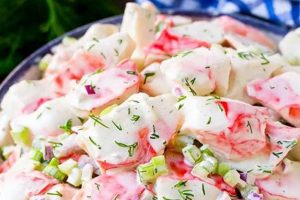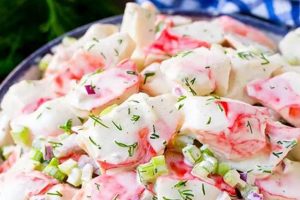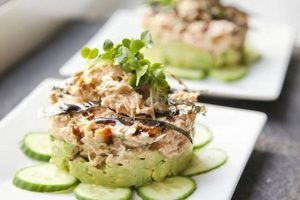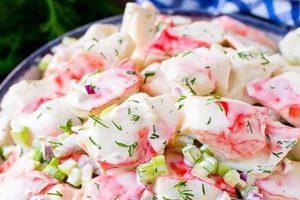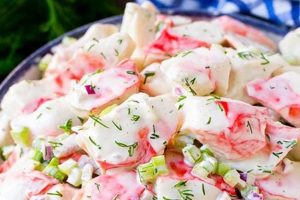Imitation crab, a seafood substitute typically made from surimi (processed white fish), forms the base of this dish category. Combined with mayonnaise, seasonings, and often vegetables like celery and onion, these salads offer a chilled, budget-friendly alternative to traditional shellfish salads. A simple version might include imitation crab, mayonnaise, celery, onion, and a touch of lemon juice, while more elaborate variations incorporate ingredients like Old Bay seasoning, bell peppers, or hard-boiled eggs.
Such salads provide a convenient and accessible way to enjoy a crab-like flavor without the expense or potential allergens associated with real crab meat. Historically, surimi-based products originated in East Asia centuries ago as a way to preserve and utilize fish. The modern iteration, frequently used in imitation crab, emerged more recently, gaining popularity as a cost-effective protein source. This affordability, combined with the ease of preparation and the ability to customize recipes to individual preferences, contributes to the enduring appeal of these dishes.
The following sections will explore various aspects of preparing these salads, including ingredient selection, diverse recipe variations, tips for enhancing flavor, and suggestions for serving and presentation. Nutritional information and potential health considerations will also be addressed.
Tips for Crafting Superior Imitation Crab Salad
Elevating imitation crab salad from satisfactory to exceptional involves attention to detail and a few key techniques. The following tips offer guidance for achieving optimal flavor and texture.
Tip 1: Quality Matters: Opt for high-quality imitation crab sticks. Look for brands with a firm texture and a delicate, slightly sweet flavor. Avoid products with an overly fishy odor or a mushy consistency.
Tip 2: Proper Thawing and Draining: Thaw imitation crab sticks completely in the refrigerator before use. Once thawed, gently squeeze out any excess liquid to prevent a watery salad.
Tip 3: Precise Chopping: Chop the imitation crab into bite-sized pieces of consistent size. This ensures even distribution of flavor and a pleasing texture. Avoid over-chopping, which can result in a mushy texture.
Tip 4: Balancing the Binder: Mayonnaise serves as the primary binder. Start with a moderate amount and add more as needed to achieve the desired consistency. Overuse of mayonnaise can result in a bland, overly rich salad.
Tip 5: Seasoning Strategically: Old Bay seasoning complements the flavor of imitation crab exceptionally well. Other seasonings like celery salt, paprika, or dill can also enhance the flavor profile. Season gradually, tasting as you go, to avoid over-seasoning.
Tip 6: Textural Contrast: Incorporating finely diced celery and red onion provides a crisp textural contrast to the softness of the imitation crab and mayonnaise.
Tip 7: Chilling is Key: Allow the salad to chill in the refrigerator for at least 30 minutes before serving. Chilling allows the flavors to meld and enhances the overall experience.
By following these tips, one can create an imitation crab salad that is both flavorful and visually appealing. Attention to ingredient quality, careful preparation, and thoughtful seasoning contribute to a superior culinary outcome.
The following section offers various serving suggestions and creative presentation ideas to further elevate the enjoyment of this versatile dish.
1. Ingredients
Ingredient selection significantly impacts the final flavor, texture, and overall quality of imitation crab salad. Understanding the role of each component allows for informed choices and recipe customization. The following facets explore key ingredient categories and their contributions to a successful dish.
- Imitation Crab
The foundation of the salad, imitation crab’s quality dictates the overall taste. Opting for a brand with a firm texture and subtle sweetness enhances the final product. Lower-quality options can have a noticeably fishy taste or an undesirable mushy consistency. The amount used determines the richness and overall crab flavor intensity.
- Binder
Mayonnaise is the typical binder, providing creaminess and holding the salad together. Alternatives include Greek yogurt or a mixture of mayonnaise and yogurt for a lighter texture and reduced fat content. The quantity of binder impacts the salad’s consistency; too much results in a loose, overly rich salad, while too little yields a dry, crumbly texture.
- Seasonings
Seasonings enhance the flavor profile of the salad. Old Bay is a classic choice, complementing the imitation crab’s flavor. Other options include celery salt, paprika, dill, or a squeeze of lemon juice. Careful balancing of seasonings is crucial to avoid overpowering the delicate crab flavor. Experimentation with different combinations allows for customization and creation of unique flavor profiles.
- Vegetables
Vegetables provide textural contrast and added flavor. Finely diced celery and red onion are common additions, offering a crisp, refreshing counterpoint to the creamy base. Other options include chopped bell peppers, water chestnuts, or shredded carrots. The choice and quantity of vegetables influence the salad’s overall texture, color, and nutritional value.
The careful selection and combination of these ingredients ultimately determine the character of the imitation crab salad. Balancing the proportions and considering the interplay of flavors and textures contributes to a well-rounded and enjoyable dish. By understanding the role of each ingredient, one can create a customized salad tailored to individual preferences.
2. Preparation Methods
Preparation methods significantly influence the final texture, consistency, and overall appeal of imitation crab salad. Proper techniques ensure optimal flavor development and prevent common pitfalls such as a watery or mushy salad. The following facets detail essential steps in the preparation process.
- Thawing and Draining
Proper thawing is crucial for both food safety and optimal texture. Thawing imitation crab sticks slowly in the refrigerator prevents bacterial growth and maintains the integrity of the crab’s texture. Once thawed, thorough draining removes excess liquid, preventing a watery salad. Squeezing the thawed crab gently between paper towels removes residual moisture effectively.
- Chopping
Chopping the imitation crab into consistent, bite-sized pieces ensures even distribution of flavor and a pleasing texture throughout the salad. Over-chopping should be avoided, as it can lead to a mushy, less appealing consistency. Aim for pieces that are roughly the same size and shape to maintain visual appeal and balanced texture.
- Combining Ingredients
The order in which ingredients are combined can impact the final result. Generally, the binder (typically mayonnaise) is mixed with seasonings first to ensure even flavor distribution. Then, the chopped imitation crab and other vegetables are gently folded in. This method prevents overmixing, which can break down the imitation crab and compromise the salad’s texture.
- Chilling
Chilling the prepared salad for at least 30 minutes before serving allows the flavors to meld and enhances the overall dining experience. Chilling also firms the salad, improving its texture and making it easier to handle and serve. Covering the salad tightly during refrigeration prevents it from drying out or absorbing odors from other foods.
Careful attention to these preparation methods contributes significantly to the success of an imitation crab salad recipe. Proper thawing, chopping, combining, and chilling techniques ensure optimal flavor, texture, and overall enjoyment of the dish. These foundational steps provide a consistent base upon which to build creative variations and personalized flavor profiles.
3. Flavor Profiles
Flavor profiles play a crucial role in defining the character of faux crab salad recipes. The delicate flavor of imitation crab serves as a neutral canvas, allowing for a wide range of flavor combinations. Understanding how different ingredients and seasonings interact allows for the creation of unique and satisfying culinary experiences. The following facets explore key flavor profile categories and their components.
- Classic
The classic flavor profile emphasizes the natural sweetness of imitation crab and incorporates traditional seasonings. Mayonnaise, celery, onion, and a touch of lemon juice create a balanced, familiar taste. This profile provides a comforting and versatile base that appeals to a broad range of palates. A pinch of Old Bay seasoning can further enhance the classic flavor profile without overwhelming the subtle sweetness of the imitation crab.
- Spicy
Spicy flavor profiles introduce heat and complexity. Ingredients like diced jalapeos, sriracha, or chili flakes add a fiery kick. Balancing the heat with acidic elements like lime juice or a touch of vinegar prevents the spice from overpowering the other flavors. This profile adds a vibrant and exciting dimension to the traditional crab salad experience.
- Tangy
Tangy profiles highlight bright, acidic notes. Increased lemon juice, the addition of Dijon mustard, or the incorporation of chopped pickles or relish provide a refreshing tartness. This profile contrasts the richness of the mayonnaise and adds a lively dimension to the overall flavor composition. Dill or other fresh herbs can complement the tangy elements, adding depth and complexity.
- Asian-Inspired
Asian-inspired flavor profiles incorporate ingredients like sesame oil, rice vinegar, ginger, and sriracha. These components introduce umami notes and a balanced sweet-and-savory flavor. The use of fresh cilantro or mint further enhances the Asian-inspired profile. This flavor direction provides a unique and flavorful alternative to traditional preparations.
The versatility of faux crab salad allows for extensive flavor customization. By understanding the interplay of different ingredients and seasonings, one can create salads that range from familiar and comforting to bold and adventurous. Experimentation with these flavor profiles opens up a world of culinary possibilities, ensuring a satisfying and personalized dining experience.
4. Serving Suggestions
Serving suggestions represent a crucial aspect of faux crab salad recipes, extending beyond mere presentation to encompass the overall dining experience. Thoughtful serving suggestions elevate this versatile dish from a simple salad to a multifaceted culinary creation. The manner in which the salad is presented influences not only visual appeal but also perceived flavor and enjoyment. Serving the salad on crisp lettuce cups, for example, provides a refreshing contrast in texture and a lighter, more healthful option compared to serving it on croissants or in a rich bread bowl. Similarly, pairing the salad with specific accompaniments, such as crusty bread or a side of fresh fruit, can create a more complete and satisfying meal.
Consideration of the target audience and occasion further refines serving choices. For a casual lunch, simple crackers or a sandwich filling might suffice. A more formal setting might call for elegant presentations using endive spears, avocado halves, or miniature phyllo cups. Presentation also affects portion control and practicality. Individual portions in small bowls or ramekins offer a controlled serving size, particularly beneficial for buffet-style events or catered gatherings. Serving the salad as a dip with an assortment of crudits expands its versatility and encourages interactive dining.
In conclusion, serving suggestions are integral to maximizing the enjoyment and versatility of faux crab salad. These suggestions are not mere afterthoughts but rather essential considerations that contribute significantly to the overall culinary experience. By understanding the interplay between presentation, accompaniments, and occasion, one can transform a simple salad into a memorable and satisfying dish. This understanding empowers culinary creativity and ensures that the faux crab salad is presented in a manner that best complements its flavors and textures, ultimately enhancing the dining experience.
5. Nutritional Considerations
Nutritional considerations are an important factor when evaluating faux crab salad recipes. While convenient and flavorful, imitation crab’s nutritional profile differs significantly from real crab. Understanding these differences allows for informed choices regarding ingredients and portion sizes. Imitation crab, primarily made from surimi (processed white fish), tends to be lower in protein and higher in sodium than real crab. Furthermore, the manufacturing process often involves adding fillers, starches, and flavor enhancers, which can contribute to a higher carbohydrate content and potentially impact overall nutritional value. For example, a three-ounce serving of imitation crab can contain upwards of 600-800 milligrams of sodium, a significant amount for individuals monitoring sodium intake. The added sugars and saturated fats present in some brands of imitation crab also warrant consideration, particularly for those managing specific dietary restrictions or health conditions.
However, the nutritional profile of the complete faux crab salad is not solely determined by the imitation crab itself. Additional ingredients, such as mayonnaise, significantly contribute to the overall fat and calorie content. Choosing lower-fat mayonnaise options, or incorporating Greek yogurt as a partial substitute, can mitigate these effects. Furthermore, the inclusion of vegetables, like celery and onions, increases fiber and vitamin content, contributing to a more nutritionally balanced meal. One might also consider adding protein-rich ingredients, like hard-boiled eggs or chickpeas, to further enhance the nutritional value of the salad. Therefore, careful consideration of all ingredients and their respective nutritional contributions is essential for creating a faux crab salad that aligns with individual dietary needs and goals. For instance, substituting finely chopped bell peppers or shredded carrots for some of the imitation crab can significantly increase the vitamin and fiber content while reducing overall sodium and carbohydrate intake.
Ultimately, nutritional awareness empowers informed recipe modifications. Adjusting ingredient ratios, selecting healthier alternatives, and being mindful of portion sizes allows individuals to enjoy faux crab salad while maintaining dietary balance. Challenges remain regarding the inherent sodium content of imitation crab. However, focusing on fresh, whole-food additions, like vegetables and lean proteins, maximizes nutritional value. This approach promotes a balanced dietary intake and transforms faux crab salad from a convenient dish into a nutritious and satisfying meal component.
Frequently Asked Questions about Imitation Crab Salad
This section addresses common inquiries regarding imitation crab salad, providing clear and concise information to dispel misconceptions and offer practical guidance.
Question 1: What is imitation crab made of?
Imitation crab, also known as surimi, is typically made from processed white fish, such as pollock or cod. It undergoes a multi-step process that involves mincing, washing, and shaping the fish into crab-like sticks or flakes. Other ingredients, such as starch, flavorings, and colorings, are often added.
Question 2: Is imitation crab healthy?
While imitation crab can be a source of protein, it is often lower in protein and higher in sodium than real crab. It’s essential to check nutritional labels and choose lower-sodium varieties when possible. Incorporating plenty of fresh vegetables into the salad can enhance its nutritional value.
Question 3: Can imitation crab salad be frozen?
Freezing imitation crab salad is generally not recommended. Freezing can negatively impact the texture of the mayonnaise and other ingredients, resulting in a watery or separated salad upon thawing.
Question 4: How long does imitation crab salad last in the refrigerator?
Properly stored in an airtight container, imitation crab salad typically lasts for 3-5 days in the refrigerator. Always check for signs of spoilage, such as a sour smell or discoloration, before consuming.
Question 5: Can individuals with shellfish allergies safely consume imitation crab salad?
Although imitation crab does not contain actual shellfish, individuals with severe shellfish allergies should exercise caution. Cross-contamination during processing or the presence of other allergens in the product are potential risks. Consulting a healthcare professional is recommended for personalized advice.
Question 6: How can one enhance the flavor of imitation crab salad?
Experimenting with different seasonings and add-ins can significantly enhance the flavor of imitation crab salad. Classic options include Old Bay seasoning, celery salt, dill, and lemon juice. Incorporating other ingredients, such as chopped bell peppers, water chestnuts, or hard-boiled eggs, adds both flavor and textural complexity.
Understanding these key aspects of imitation crab salad allows for informed choices regarding ingredient selection, preparation, and consumption. This knowledge empowers informed decision-making and enhances appreciation for the culinary possibilities of this versatile ingredient.
The following section offers a collection of diverse imitation crab salad recipes, catering to various tastes and dietary preferences.
Faux Crab Salad Recipes
Exploration of faux crab salad recipes reveals a versatile dish adaptable to various flavor profiles and dietary preferences. From classic preparations emphasizing simplicity to innovative variations incorporating diverse ingredients, the potential for culinary creativity is extensive. Careful ingredient selection, proper handling techniques, and attention to seasoning contribute significantly to the final product’s quality and enjoyment. Nutritional considerations highlight the importance of balancing convenience with healthful choices. Understanding the composition of imitation crab and incorporating nutrient-rich additions, such as fresh vegetables and lean proteins, enhances the overall nutritional value of this adaptable dish.
Faux crab salad recipes offer a canvas for culinary expression. Further exploration of global flavor influences and innovative ingredient combinations promises to expand the culinary landscape of this dish. Continued emphasis on ingredient quality and mindful preparation techniques will elevate faux crab salad beyond a simple imitation, establishing it as a unique and respected culinary creation in its own right.

